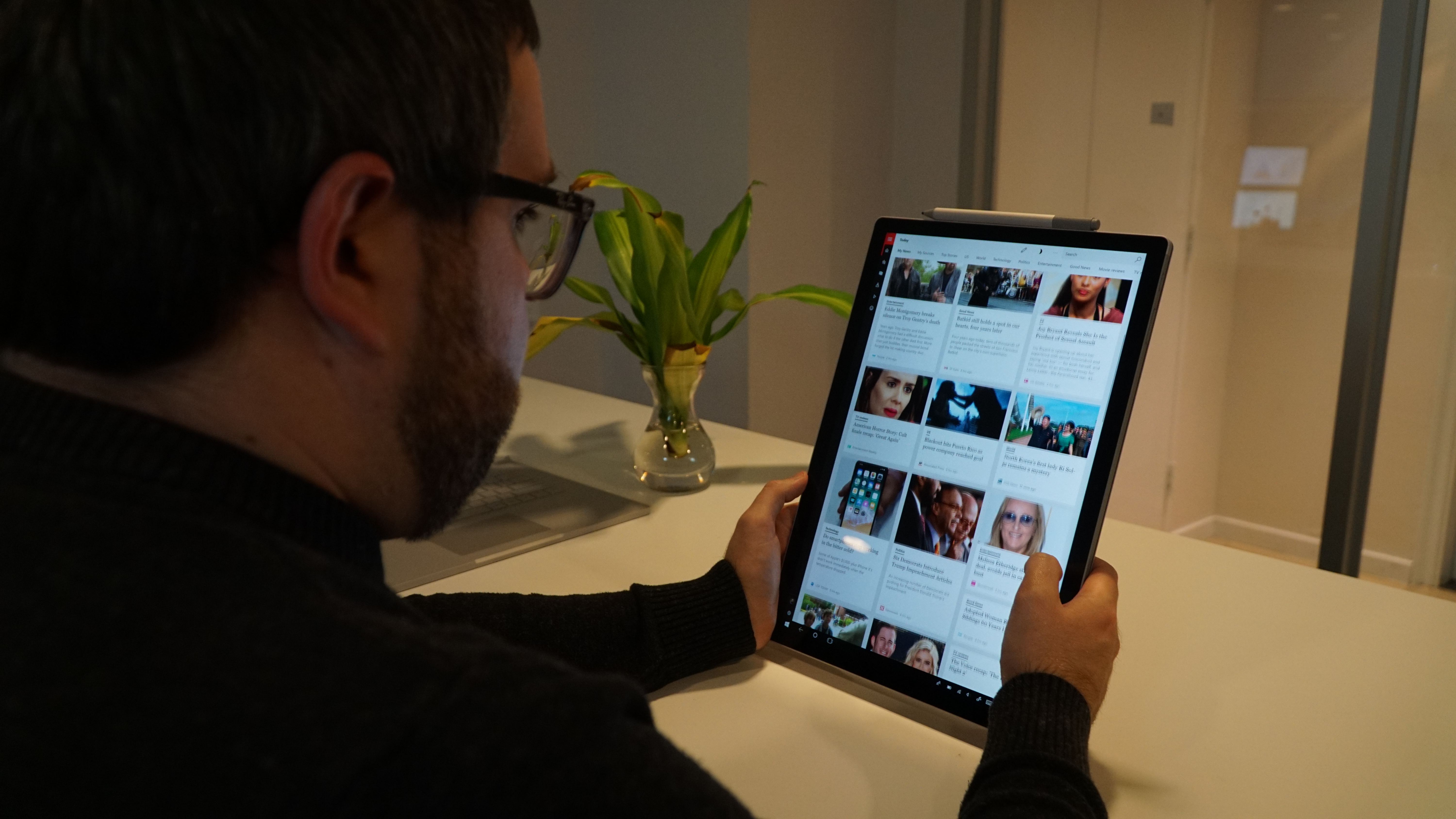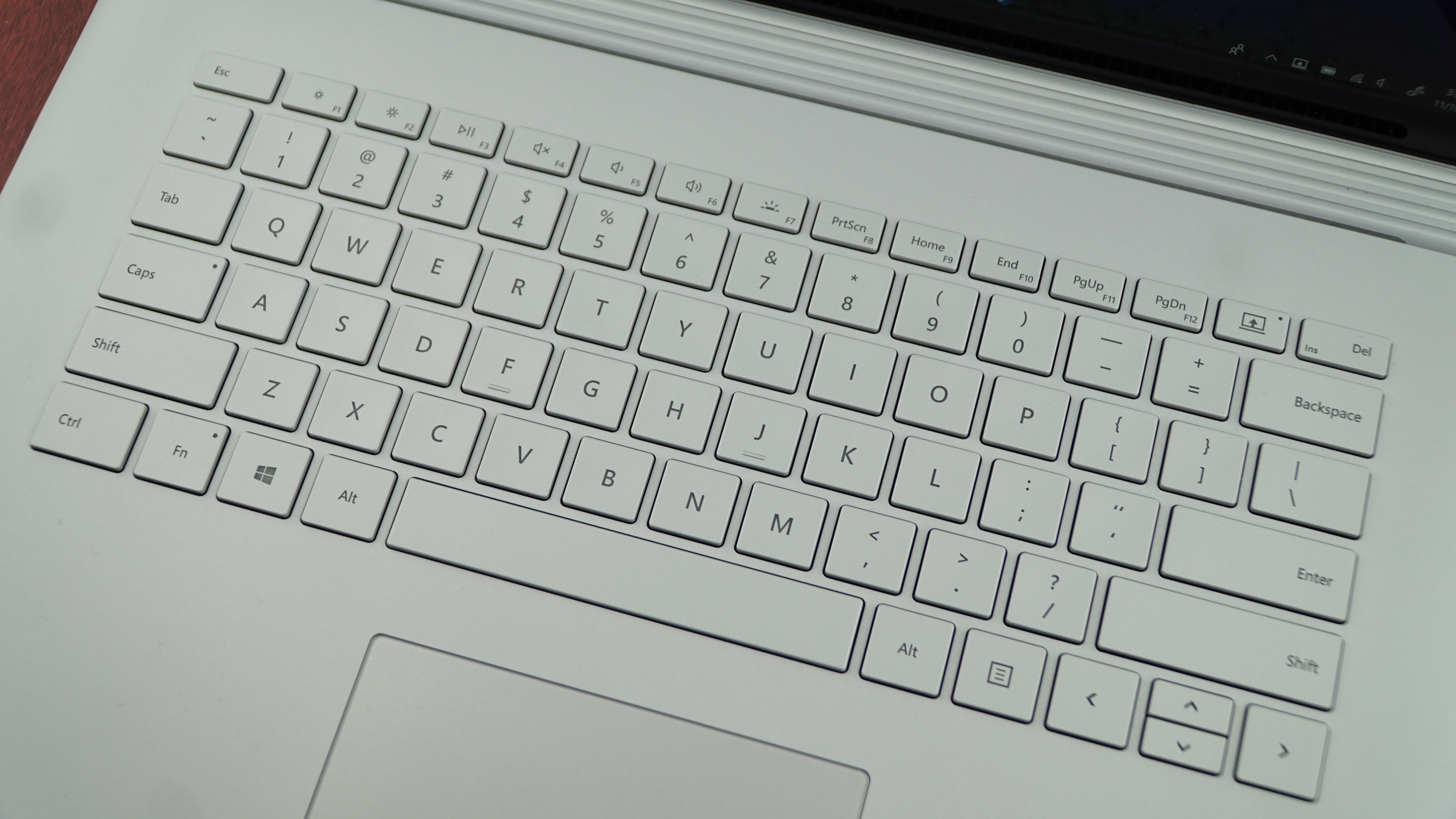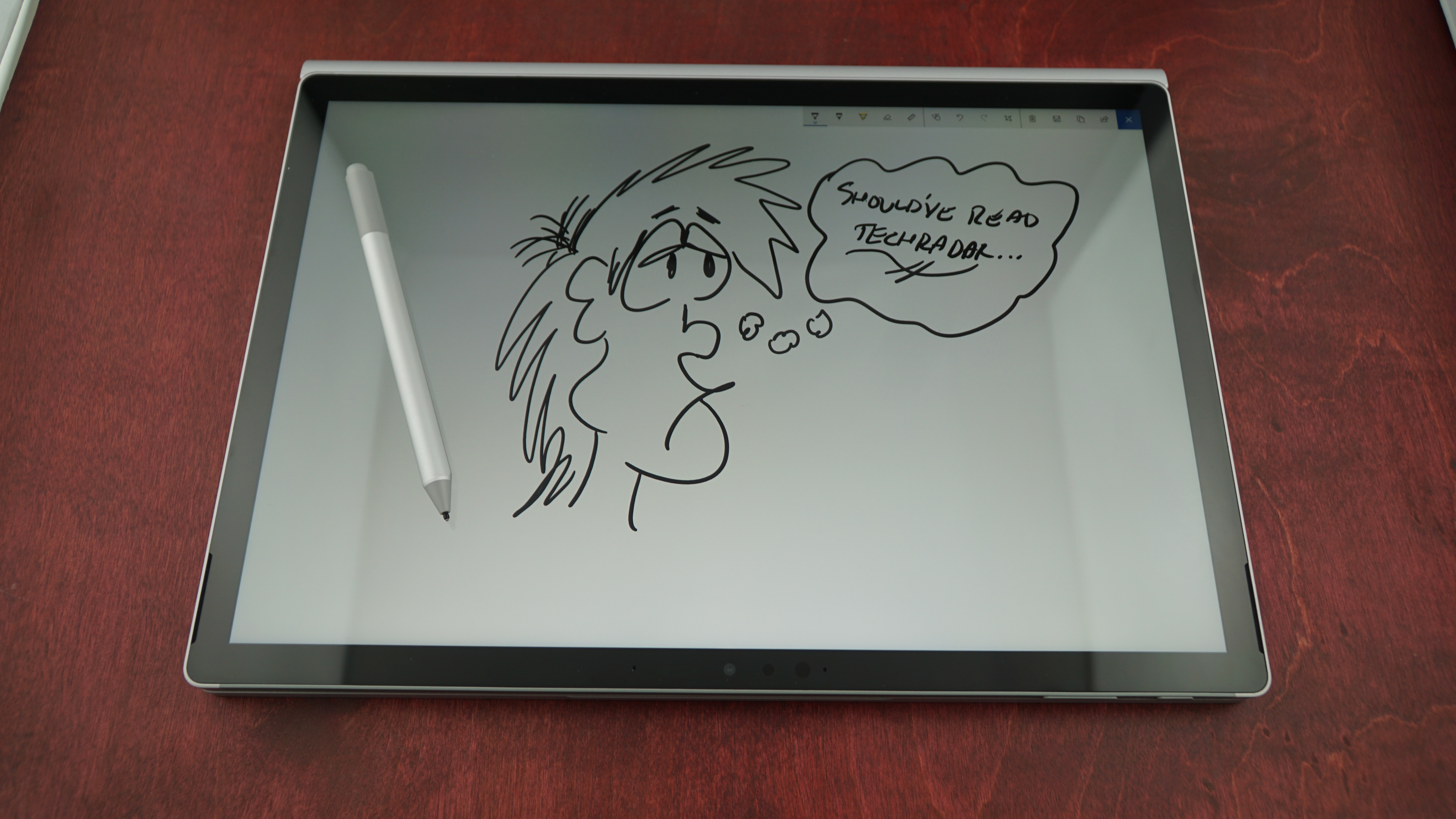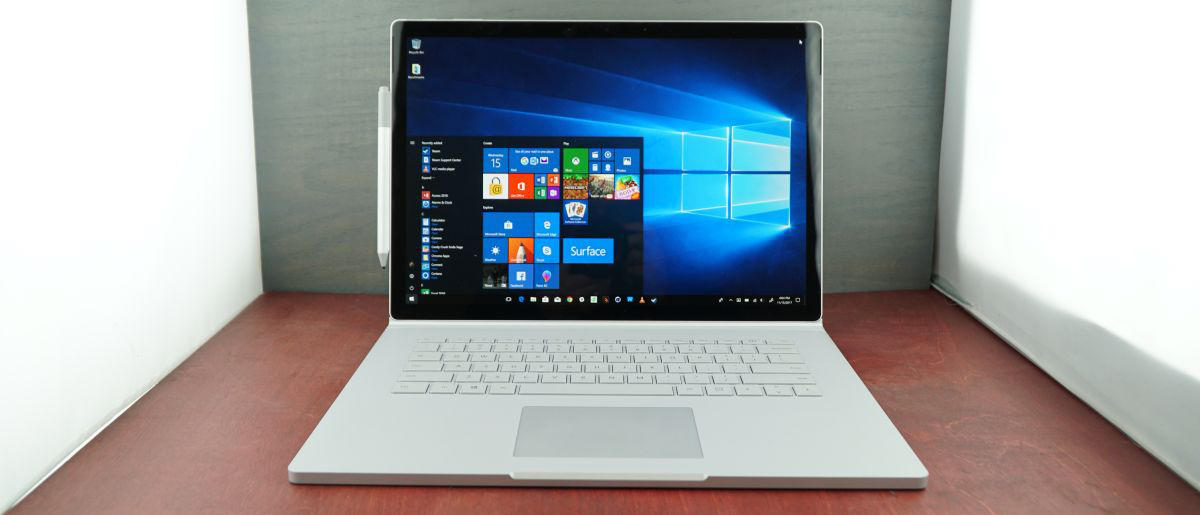TechRadar Verdict
As it turns out, one of the best 2-in-1 laptops to date is just a larger Surface Book – one that can handle the latest PC games and last for a helluva long time, to boot. Not to mention that this is the best tablet for drawing that we’ve tested yet. We just wish Microsoft did a bit more with the extra space afforded by the new 15-inch form factor.
Pros
- +
Crazy long battery life
- +
Massively powerful
- +
Lightweight yet large tablet
- +
Excellent cooling
Cons
- -
No up-firing base speakers
- -
Small trackpad
- -
Very pricey
- -
No Surface Pen included
Why you can trust TechRadar
In many ways, the Microsoft Surface Book 2 15-inch surpasses the MacBook Pro and gives it a real run for its money. It takes everything we love about the original Surface Book and raises the bar a bit with an upgraded Dynamic Fulcrum Hinge as well as a bigger display in a slimmer form factor.
Microsoft’s next Surface Pen could be a smart stylus usable across all devices
Microsoft quietly upgrades Surface Book 2 with 8th generation Intel Core i5 processor
Unfortunately, those improvements also come at a price, as the Microsoft Surface Book 2 15-inch is also more expensive. But is it worth it? Considering how impressive its refinements are, absolutely. And, we’re looking forward to how the Surface Book 3 takes these refinements and improves on them further.
If you’re looking for the best 2-in-1 laptops out there, look no further than the Microsoft Surface Book 2 15-inch.
Here is the configuration for the Microsoft Surface Book 2 (15-inch) configuration sent to TechRadar for review:
CPU: 1.9GHz Intel Core i7-8650U (quad-core, 8MB cache, up to 4.2GHz with Turbo Boost)
Graphics: Intel UHD Graphics 620; Nvidia GeForce GTX 1060 (6GB GDDR5 VRAM)
RAM: 16GB LPDDR3 (1866Mhz)
Screen: 15-inch, 3,240 x 2,160 (260 ppi) PixelSense display (3:2 aspect ratio; 1600:1 contrast ratio)
Storage: 1TB PCIe 3.0 SSD
Ports: 2 x USB 3.1, 1 x USB 3.1 Type-C, 2 x Surface Connect, SD card reader, 3.5mm audio jack
Connectivity: 802.11ac 2 x 2 MIMO Wi-Fi, Bluetooth 4.1, Xbox Wireless
Camera: Windows 8MP rear-facing autofocus camera (1080p), 5MP front-facing Hello face-authentication camera (1080p HD)
Weight: 4.2 pounds (1.9kg) with keyboard base
Size: 13.5 x 9.87 x 0.568 ~ 0.90 inches (343 x 251 x 15 ~ 23mm; W x D x H)
Price and availability
This shouldn’t come as a surprise, but the Surface Book 2 is very expensive. The configuration we reviewed here, listed to the right, comes in at a lofty $3,299 in the US. Of course, this is the highest end that the Surface Book 2 gets, with the entry-level 15-inch model coming in at a still hefty $2,499 (£2,349, AU$3,649). The only difference between the two is that the starting Surface Book 2 configuration comes with a 256GB SSD.
In the UK, the larger Surface Book 2 can be configured to have twice the amount of storage with the 256GB model for £2,749, or with a 1TB SSD for £3,149. Meanwhile, in Australia, the 512GB Surface Book 2 is $4,249, whereas the 1TB version sells for $4,849 including GST.
On the other hand, the 13.5-inch Surface Book 2 starts at the fairly more modest price of $1,149 (£1,149, AU$1,599) in the US, with other countries likely to follow this pricing model. Sadly, you will have to sacrifice storage space to get this low price – you’ll be limited to 128GB of storage accompanying the dual-core i5 CPU and 8GB of RAM.
The Surface Book 2 is undoubtedly a pricey device, especially considering that the price doesn’t even include the $99 (£99, AU$139) Surface Pen. And, yes, we’re going to keep calling Microsoft out on this decision until it starts bundling this practically required accessory in with its Surface devices once again.
For comparison’s sake, Apple’s 15-inch MacBook Pro with Touch Bar starts at $2,399 (£2,349, AU$3,499) for a 7th-generation Intel Core i7 processor, an AMD Radeon Pro 555 graphics chip with 2GB of VRAM, 16GB of memory and a 256GB SSD – all powering a 2,880 x 1,800-pixel 15.4-inch display at 220 pixels per inch as well as an OLED Touch Bar.
The Surface Book 2 is just $100 more than the 15-inch MacBook Pro, but you’re also getting a more powerful processor and a beefier GPU. And, that’s behind a crisper display with touch control so it can function as a tablet. Not accounting for taste, it’s hard to argue with the fact that the Surface Book 2 is the better value here. Plus, a year later, you should be able to find some deals that up the value proposition of the Surface Book 2.

Design
In terms of the Surface Book 2’s look and feel, in all its brushed aluminum glory, it’s an understatement to say that Microsoft took the Surface Book and blew it up in every way to make the Surface Book 2 the stunning 15-inch device that it is. While Microsoft did evidently put a lot of effort into considerably improving the Surface Book 2’s power profile and screen technology, this is, in many ways, a bigger Surface Book.
We’re not complaining, however – Microsoft learned some valuable lessons from the Surface Book, evolving it into the thin, light and power-packed Surface Book 2. What’s more, when detached from the base, the Surface Book 2 is the lightest 15-inch tablet we’ve ever gotten our hands on – it feels smaller than it actually is.
That said, the Surface Book 2’s fulcrum hinge does make for a laptop that’s a bit more unwieldy to cram into a backpack than most, and it’s now more exaggerated than ever. Worse still, Microsoft didn’t make the most design-wise with the extra space that 15 inches affords you.
For instance, the glass trackpad isn’t quite as wide or deep as, say, the 15-inch MacBook Pro when it really could have been, given the amount of space under the keyboard. The lack of up-firing stereo speakers in the base is also a major disappointment, as there’s plenty of room on all three remaining sides of the keyboard for additional audio chambers.

Instead, we’re stuck with rather tinny, front-firing speakers on the tablet portion of the device. The bigger keyboard base should offer us bigger everything, frankly, not just bigger graphics. Worse yet is the positioning of the audio jack in the same odd, upper-right-edge location it’s always been, dangling over our hands and getting in the way of us typing.
In spite of that, the typing experience with the Surface Book 2 is phenomenal, with a brightly backlit keyboard that has punchy feedback and satisfying travel. We would like to see a bit more force in the keyboard’s feedback, but that could just be down to personal taste.
All things considered, we like the Surface Book 2 (15-inch) design quite a bit – even its 1080p webcam and rear camera should get approving looks at the next meeting or in your Instagram feed. However, we still can’t forgive the missed opportunities to refine the product that much further and make the experience that much bigger when it comes to how it feels, looks and sounds.

Display and Surface Pen
Of course, we’re just as in love with the Surface Book 2 (15-inch) display as we were with the earlier models. Text looks sharp on the screen as do photos and videos, even if the 3:2 aspect ratio makes for some inelegant thick black bars when viewing the latter.
The display’s resolution only falls short next to 4K laptops, and Apple’s MacBook displays can’t hold a candle to it pixel for pixel. While Apple’s P3 color gamut might tower over Microsoft’s panel in the eyes of art and media pros, we don’t see much difference between the two in terms of color reproduction.
We’re told that Microsoft dedicated considerable effort to improving the touch response in its latest PixelSense display for the Surface Book 2, and this shows in testing. If any latency between drawing on the display with the Surface Pen and its appearance on the screen was there before, it’s definitely indiscernible now.

In fact, if you scribble on a sticky note and run the Surface Pen off of the note window – you’ll see traces of ink appear on whatever is there, although it will almost instantaneously disappear. That’s a special processor rendering the ink before even Windows 10 does, we’re told, which should speak to the absence of lag in the touchscreen.
Additionally, attaching and detaching the screen from the keyboard base is as quick and effortless as you’d expect from a wildly expensive computing device. Whether it’s going into tablet mode or back into a laptop, it’s less than a second before you’re already tapping or typing away.
In any case, the Surface Book 2 screen just proves that Microsoft can craft displays that can hold its own against the world’s greatest in basically every metric.
Images Credit: TechRadar
- To save money on US and UK purchases, check out our Microsoft promo codes to get the best deals on Microsoft products.
- 1
- 2
Current page: Introduction, price, design and features
Next Page Performance, battery life and verdictJoe Osborne is the Senior Technology Editor at Insider Inc. His role is to leads the technology coverage team for the Business Insider Shopping team, facilitating expert reviews, comprehensive buying guides, snap deals news and more. Previously, Joe was TechRadar's US computing editor, leading reviews of everything from gaming PCs to internal components and accessories. In his spare time, Joe is a renowned Dungeons and Dragons dungeon master – and arguably the nicest man in tech.

